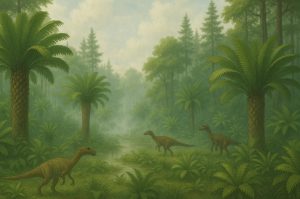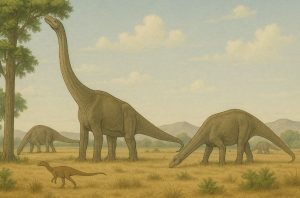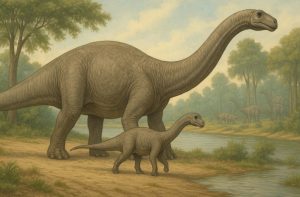What Made Dinosaurs Grow to Such Enormous Sizes?
Why were some dinosaurs, such as Argentinosaurus, larger than modern planes and weighing over 70 tonnes? What environmental and biological forces contributed to such incredible size?
The question of why dinosaurs reached such gigantic proportions has puzzled scientists for decades and continues to be a subject of intense study.
The immense size of many dinosaurs, particularly long-necked sauropods, was not merely a fluke of nature.
Instead, it was the result of a complex interaction of evolutionary pressures, favourable environmental conditions, and unique physiological traits.
This article explores those contributing factors and what they tell us about Earth’s distant past.
How Did the Mesozoic Era Climate Influence Dinosaur Size?

The Mesozoic Era, spanning from around 252 to 66 million years ago, was divided into three distinct periods: Triassic, Jurassic, and Cretaceous.
Each phase offered relatively warm and stable global climates, creating ecosystems that were ideal for large terrestrial vertebrates.
During this era, Earth experienced higher atmospheric oxygen and carbon dioxide concentrations than today. These gases played a significant role in sustaining vast forests and plant life, particularly in the Jurassic and Cretaceous periods.
The abundance of vegetation provided herbivorous dinosaurs with ample food sources, which, in turn, could support their colossal frames.
Palaeoclimate data also indicate reduced temperature fluctuations and minimal seasonality across much of the globe.
This climate stability likely helped reduce environmental stressors, enabling consistent growth patterns across dinosaur populations.
What Evolutionary Advantages Did Gigantic Size Offer?
Size often provides an organism with evolutionary advantages, and in the case of dinosaurs, these benefits were particularly pronounced.
For herbivores, such as the Diplodocus or Apatosaurus, being large made it easier to reach higher vegetation, allowing them access to food that smaller competitors couldn’t exploit.
Moreover, their bulk would have deterred predators and offered greater physical resilience.
For carnivorous dinosaurs, increased size meant a stronger bite force, longer stride lengths, and better endurance during hunting or scavenging. Larger predators could cover more ground and exert dominance within their ecological niche.
From an evolutionary standpoint, large size may have also:
- Improved reproductive success through greater protection of offspring
- Allowed higher energy storage and efficiency in movement over long distances
- Reduced vulnerability to predation, particularly for slow-moving herbivores
Why Were Sauropods the Largest Dinosaurs?

Among the various types of dinosaurs, sauropods consistently rank as the largest. These long-necked herbivores displayed an extraordinary combination of anatomical adaptations that allowed them to achieve their massive dimensions.
One crucial factor was their unique skeletal structure. Sauropods had lightweight, pneumatic bones filled with air sacs, which significantly reduced their overall body mass without compromising strength.
This adaptation made it physically possible to grow to immense sizes without collapsing under their own weight.
Additionally, their elongated necks enabled them to browse across vast areas of vegetation without moving frequently, thus conserving energy.
Studies suggest their digestive systems were also highly efficient, capable of processing enormous volumes of fibrous plant material slowly but effectively.
Another important consideration is their respiratory system, which was similar to that of modern birds. This unidirectional airflow system allowed for more efficient oxygen absorption, crucial for supporting large body sizes.
| Feature | Adaptation in Sauropods |
| Skeletal System | Pneumatic, lightweight bones |
| Neck Length | Up to 15 metres in some species |
| Respiration | Air sacs enable efficient oxygen intake |
| Diet | High-volume, low-nutrient plant matter |
How Did Metabolism and Thermoregulation Impact Size?
A longstanding debate in palaeontology revolves around the metabolic nature of dinosaurs. Were they cold-blooded like modern reptiles or warm-blooded like mammals and birds? The answer appears to be somewhere in between.
Many scientists now support a theory called gigantothermy, or inertial homeothermy. This concept suggests that once dinosaurs reached a certain size, their body temperature remained stable due to thermal inertia.
In other words, their sheer bulk helped retain heat generated by muscle activity and metabolic processes, reducing dependence on external temperature sources.
This semi-regulated internal temperature would have enabled dinosaurs to remain active across various climates, particularly useful for large species living in different geographical regions.
Some fossil evidence, such as isotopic analysis of bones, indicates that certain dinosaur groups may have exhibited metabolic rates similar to modern birds and mammals, supporting a form of warm-bloodedness.
Did Dinosaurs Grow Quickly and Live Long Lives?

Growth rates in dinosaurs were remarkably fast, particularly in larger species. Fossilised bone tissues often show tightly packed growth rings, indicating accelerated development during juvenile years.
Some sauropods are believed to have grown from hatchlings to 30-tonne adults in just 20 to 30 years—a rate unmatched in most modern vertebrates.
Long lifespans also contributed to their enormous size. Dinosaurs that lived for several decades could grow continuously, particularly in environments where food was abundant and competition limited.
Evidence suggests some of the largest species may have lived for over 70 years.
Studies of bone histology and microstructure reveal how blood vessels were distributed throughout the bone matrix, supporting rapid nutrient delivery and growth.
These studies further confirm that dinosaurs had efficient biological systems capable of supporting their vast physical demands.
What Ecological Conditions Supported Gigantic Dinosaurs?
Ecological support was a major enabler of dinosaur gigantism. The prehistoric environment lacked the dense populations of large mammals and human-induced pressures seen today.
This absence of competition allowed dinosaurs to dominate terrestrial ecosystems without significant rivalries for resources.
Massive herbivores thrived in forested floodplains, where vegetation was plentiful and widespread.
Their large body size allowed them to migrate across vast distances in search of food and water, often in herds that could reshape entire landscapes.
Predators such as Allosaurus or Tyrannosaurus rex maintained the balance, preying on the young or weak and driving evolutionary arms races that led to size increases in both predator and prey.
Environmental stability and vast uninhabited land masses also provided the space and time required for these animals to evolve to such sizes without the interruptions of glaciations or human expansion that characterise recent history.
What Does the Fossil Record Reveal About Dinosaur Size?
The fossil record provides crucial insights into the lives of dinosaurs, including how and why they grew so large.
Although often fragmentary, fossils allow scientists to reconstruct skeletal structures, estimate muscle mass, and predict overall body size.
Advanced techniques such as:
- CT scanning of fossilised bones
- 3D digital modelling
- Laser scanning of fossil tracks
have revolutionised our ability to understand dinosaur anatomy and movement. From these models, researchers can determine not just size but also posture, stride length, and even likely feeding behaviour.
Comparative studies with modern-day descendants, such as birds and reptiles, help refine these estimates and lend credibility to size reconstructions.
| Dinosaur | Estimated Length | Estimated Mass |
| Argentinosaurus | 30–35 metres | 70–100 tonnes |
| Brachiosaurus | 25 metres | 40 tonnes |
| Tyrannosaurus rex | 12–13 metres | 9 tonnes |
| Stegosaurus | 9 metres | 3–5 tonnes |
Could Dinosaurs Reach Similar Sizes in Today’s World?

The answer is almost certainly no. Modern Earth presents a very different landscape, climate, and atmospheric composition than that of the Mesozoic Era.
Today’s oxygen levels are lower, and vegetation is less abundant and less nutritious than the carbon-rich plants of the past.
Moreover, the pressures of human civilisation, habitat fragmentation, and climate change would prevent the development of such large terrestrial animals.
In aquatic environments, where buoyancy offsets gravity, animals like the blue whale have managed to exceed the mass of even the largest dinosaurs, but on land, such feats are no longer viable.
Terrestrial megafauna today, such as elephants and giraffes, still show impressive size but are pale comparisons to their prehistoric predecessors. These modern giants are also limited by different biomechanical and ecological constraints.
What Can We Learn From the Gigantic Size of Dinosaurs?
Studying the size of dinosaurs offers more than just a glimpse into a long-lost world; it helps scientists understand evolutionary pressures, biomechanical adaptations, and environmental changes over deep time.
The phenomenon of dinosaur gigantism highlights how nature, under the right conditions, can produce truly extraordinary outcomes.
From climate and oxygen levels to anatomy and reproductive strategies, the story of dinosaur size is a tale of complex interdependencies.
It also reminds us that size alone did not guarantee survival, as these giants ultimately succumbed to one of the most catastrophic mass extinction events in Earth’s history.
Frequently Asked Questions
Were all dinosaurs extremely large?
No, many dinosaurs were modest in size. Some species, such as Compsognathus, were only about the size of a modern chicken. Size varied widely across different groups and eras.
How do scientists estimate the size of dinosaurs?
By studying fossilised bones, particularly the femur and skull, scientists can model body proportions. 3D simulations and comparisons with living animals also help refine estimates.
Did being large help dinosaurs survive longer?
Size offered certain survival advantages, such as deterrence against predators and energy efficiency, but did not make them immune to extinction pressures.
Why are there no land animals that big today?
Modern ecosystems cannot support such large land animals due to lower oxygen levels, limited resources, and environmental instability caused by human activity.
Did climate change affect dinosaur size?
Yes, climate directly influences the availability of vegetation and habitat. Warmer and more stable conditions during the Mesozoic supported larger body sizes.
Were carnivorous dinosaurs as large as herbivores?
Generally, no. While some predators like Tyrannosaurus rex were massive, herbivores such as Argentinosaurus and Diplodocus were often significantly larger.
Is there a modern-day animal comparable in size to dinosaurs?
The blue whale surpasses dinosaurs in overall mass, but it lives in water. On land, the African elephant is the largest living animal, yet far smaller than the largest sauropods.






